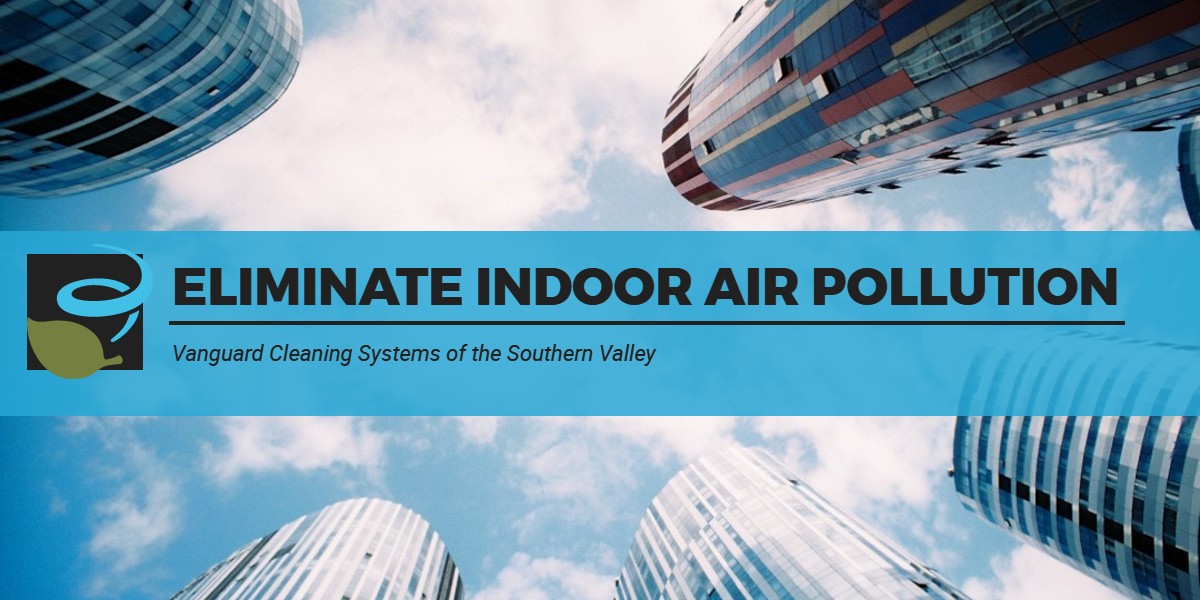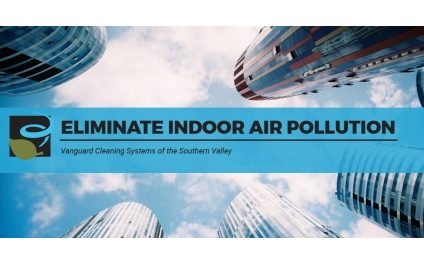Check out our latest green janitorial service tips to help improve the quality of life in your school or office by eliminating indoor air pollution.

Professional Janitorial Service Tips to Eliminate Indoor Air Pollution
Indoor air pollution is an enormous problem for schools and businesses in the U.S., with both immediate and long-term health implications.
According to eSchoolToday;
Air pollutants can be in the form of particulate matter which can be very harmful to our health.
The level of effect usually depends on the length of time of exposure, as well the kind and concentration of chemicals and particles exposed to.
Short-term effects include irritation to the eyes, nose, and throat, and upper respiratory infections such as bronchitis and pneumonia.
Others include headaches, nausea, and allergic reactions.
Short-term air pollution can aggravate the medical conditions of individuals with asthma and emphysema.
Long-term health effects can include chronic respiratory disease, lung cancer, heart disease, and even damage to the brain, nerves, liver, or kidneys.
Continual exposure to air pollution affects the lungs of growing children and may aggravate or complicate medical conditions in the elderly.
Tips to Eliminate Indoor Air Pollution and Improve Indoor Air Quality
Indoor air pollution and quality are complex issues that, unfortunately, do not have simple solutions.
However, there are several cost-effective steps schools and businesses can take to eliminate sources of indoor toxins.
Smoke/Cigarette Smoke
Smoke, especially from cigarettes, can carry a large volume of carcinogenic particles that can be difficult to filter out, especially secondhand smoke that can 'stick' to a smokers clothing, and travel with them indoors.
For cigarettes, corporate cessation plans can do wonders for financial bottom lines and health costs, as well as building occupant and customer satisfaction.
Smoke from California's unceasing wildfires is another matter that complicates the need to induce outdoor air flow inside.
To combat this issue, as with many other particulate pollutants, ensure your air ducts and vents are serviced regularly and employ high-grade HEPA filtration systems.
On a relevant note; make sure to do your research on consumer-grade desktop air filtration systems to ensure they are not primary sources of elevated indoor ozone levels.
Cleaning Products
Commercial and consumer grade cleaning products are primary sources of indoor air pollution--off-gassing Volatile Organic Compounds (VOCs)--have been shown to aggravate pre-existing health conditions, especially in smokers, as well as contribute to a host of short and long-term ailments.
VOCs have also been shown, in lab tests with mice, to inflame the hippocampus, causing permanent brain damage, including autism and depression, where no symptoms previously existed, all in a very short amount of time, and after limited exposure.
According to Federal law, manufacturers are not required to divulge the full chemical content of any product where the misuse of said product (e.g., consumption) has not been shown to cause immediate harm.
In other words, if a cleaning product contains toxic chemicals scientifically documented to cause an assortment of health issues, from cancer to genetic reproductive problems, but the effect of exposure to those chemicals through misuse is not immediate, the manufacturer is not required to divulge the existence of said chemical on the label
Switching to certified green cleaning products and eliminating the use of all hazardous cleaning chemicals has been shown to provide rapid health and financial benefits to organizations who have made the permanent commitment to healthier working and learning environments.
See Also:
Pest Control
While pests and rodents in your home, office, or classroom can be a nightmare to deal with, often bringing their own adverse health aspects indoors with them, the conventional practice of implementing toxic pesticides and poisons to eliminate the infestation has been shown to cause more harmful side-effects than position results.
Modern LEED-certified schools and office complexes focus on safer methods that only turn to toxic chemicals as a last resort, and only after careful planning and public notification before implementation.
Prevention is the best method, which typically requires experienced and ongoing facilities maintenance, to reduce or eliminate environmental elements that attract pests or allow them access indoors.
This can involve a broad range of policy changes, such as where trash bins are located, where food can be consumed, how garbage is handled, and how infrastructure damage, such as cracks in walls or pipes, are prioritized and addressed.
Green Cleaning Tips
- A cigarette is harmful and dangerous to everyone. Consider plans that eliminate its use on or near any facilities, as well as company sponsored cessation plans.
- Ensure craft work, printing, cooking, and the use of other toxic chemicals occurs in well-ventilated spaces.
- Reduce or eliminate clutter to combat the buildup of dust and other allergens, as well as remove likely hiding spots for rodents and other pests.
- Cover trash receptacles and remove bins to locations well away from any regularly occupied buildings.
- Removing shoes, though practical for many reasons, is not common in U.S. schools and businesses. However, shoes can track in a host of toxic chemicals, germs, bacteria, and other microbes that can negatively impact indoor environments. The best way to combat this, sans a no-shoes policy, is to implement high-performance walkway matting systems, and routine commercial carpet cleaning and vacuuming services.
- Eliminate the use of indoor air fresheners. The chemicals commonly found in these types of perfumes aerosols, candles, waxes, and liquid infusers, while independently harmless, can combine with ozone in the air to form a synthetic kind of formaldehyde.
- Implement and monitor air quality control systems, and check occupied spaces for carbon monoxide and other toxic fumes that cannot be easily filtered by HVAC and desktop filtration systems.
- Fix all water leaks immediately to avoid the growth of mold and bacteria which, depending on the type of spore, can cause immediate and severe allergic reactions and other health issues. Make sure to test for mold and mildew along soiled areas after the leak is repaired to avoid missing small scale growths before they blossom into full-scale, and costly, health concerns.
- Dust at least once per week, depending on occupancy use, and vacuum at least once daily, based on foot traffic.
- Have your exhaust vents, fans, and HVAC ducts serviced and cleaned regularly to ensure optimal performance and remove particulate matter.
For More Information:
References & Resources
- Improving Indoor Air Quality
- 7 easy ways to reduce indoor air pollution
- Breathe Easy: 5 Ways To Improve Indoor Air Quality
- 16 Ways to Eliminate Indoor Air Pollution
Takeaway
Indoor air pollution is a serious and complex issue that has suffered in silence due to a lack of widespread information regarding its effects on building occupants, especially young children in outdated classrooms, or workers in refurbished buildings, precisely where those individuals are exposed to additional toxic chemicals, such as commercial cleaning products.
Depending on the nature, size, and complexity of your facility, locating and eliminating the source of indoor air pollution can be difficult without the assistance of an experienced professional.
If you would like to learn more about how a professional janitorial service provider can assist your organization with the elimination of indoor air pollution, contact us today for a free quote!
In Bakersfield CA, call (661) 437-3253
In Fresno CA, call (559) 206-1059
In Valencia CA, or Santa Clarita CA, call (661) 437-3253

